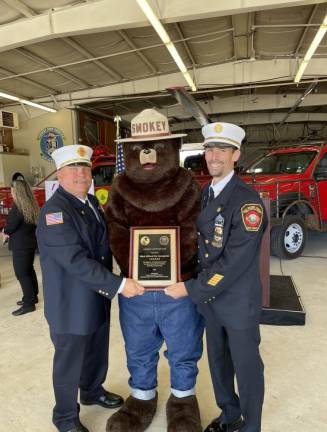West Milford fire companies honored
NEW JERSEY. The fire companies were recognized ‘for distinguished service during the extraordinary event of wildfires in New Jersey.’

The six West Milford fire companies received Interagency Cooperators Award from the state Department of Environmental Protection’s Forest Fire Service “for distinguished service during the extraordinary event of wildfires in New Jersey” during the spring.
The awards were presented Thursday, Sept. 21 at a ceremony recognizing individuals and agencies that assisted during New Jersey’s most active wildfire season in more than a decade.
“Without the cooperation of our interagency partners, the Forest Fire Service’s job would be immensely more difficult,” said Greg McLaughlin, administrator and chief of the Forest Fire Service. “Celebrating these interagency partners is a reminder that preventing wildfires and keeping the public safe requires the support and commitment of many people and departments.”
At the ceremony at Coyle Field Forest Fire Service air attack base in Burlington County, the service also honored Christopher Warwick, a trooper with the New Jersey State Police Office of Emergency Management; Michael Mastronardy, the Ocean County sheriff; Kristen Carr, deputy emergency management coordinator of the Burlington County Office of Emergency Management; Stephen Letts, captain of the Fire Investigations K-9 Unit in the State Fire Marshal’s Office; and Whiting Volunteer Fire Company No. 1.
The West Milford firefighters were recognized for their work in fighting the Kanouse wildfire, which burned 972 acres and caused the evacuation of five homes in the township in April.
The awards presentation coincided with Climate Week, highlighting climate change and actions that can be taken to become more resilient and mitigate its impacts.
$3M more for budget
With New Jersey facing increasing wildfire risks because of climate change, Commissioner of Environmental Protection Shawn LaTourette said the Murphy administration is providing an additional $3 million to the Forest Fire Service budget for new equipment and staff.
“The need to further strengthen our Forest Fire Service cannot be understated during Climate Week as the impacts of climate change increase the frequency and intensity of wildfires right here at home,” he said.
“In addition to protecting lives and property, our Forest Fire Service assists with natural disasters, maintains hundreds of miles of roads, works alongside multiple cooperators to develop and implement strategic plans that reduce the risk of future wildfires, and lends their talents to other states when wildfires strike.”
The $3 million will help upgrade the Forest Fire Service’s aging fleet of equipment. All fire engines used by the Forest Fire Service are constructed and modified in-house at the service’s Research and Development facility, resulting in significant cost savings.
The specially designed engines are equipped to access difficult-to-reach areas of New Jersey’s forests while keeping firefighters safe during a growing wildfire.
Additional funds will be made available to expand the Forest Fire Service’s contracted air support during peak spring fire season and to help fund full-time employees that will fill critical vacancies.
“This year we saw the challenges the Forest Fire Service can face with a prolonged wildfire season and multiple significant wildfires burning simultaneously in the Pinelands and elsewhere throughout the state,” said John Cecil, assistant commissioner for State Parks, Forests & Historic Sites. “It is imperative that we provide our brave wildland firefighters the best resources possible to do their jobs safely while they protect lives and property.”
Wildfire season in New Jersey historically has been from mid-March through mid-May but has increased noticeably in length during the past decade, with major wildfires occurring in February and extending into summer.
In New Jersey, 99 percent of wildfires are caused by people, through accidents, carelessness and arson. The rest are caused by lightning strikes.
Major wildfires continued to flare through the summer; the most recent was the Dragway Wildfire in late August that burned 1,778 acres and the Airpark Wildfire that burned more than 800 acres during Labor Day weekend. Both fires were in the wildfire-prone Pinelands region.
A new nationwide analysis of weather conditions during the past 50 years by the nonprofit Climate Central found that the annual number of days with a high risk of wildfire has increased by 10 days in northern New Jersey and four days in southern New Jersey.
The 2020 New Jersey Scientific Report on Climate Change said wildfire seasons are expected to lengthen and the frequency of large fires will increase because of hot, dry periods that will result from increasing temperatures.
So far in 2023, the Forest Fire Service has responded to 1,034 wildfires, which have burned 17,979 acres in New Jersey. Fourteen of the fires were considered to be major wildfires, burning more than 100 acres, making 2023 the busiest fire season in more than a decade.
The most significant of these fires include the Jimmy’s Waterhole Wildfire in Manchester and Lakehurst in Ocean County, which burned 3,450 acres and caused the evacuation of 170 homes; the Allen Road Wildfire in Bass River Township, Burlington County, which burned 5,474 acres, forced the evacuation of a campground and the closure of a portion of the Garden State Parkway; the Kanouse wildfire in West Milford; and the Flat Iron Wildfire in Medford, Burlington County, which burned 212 acres and threatened 40 homes.
Also among the 14 major wildfires this year was the Cannonball Wildfire, which burned 102 acres in Pompton Lakes, Passaic County, on May 13.